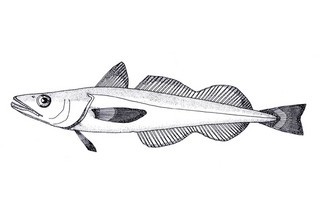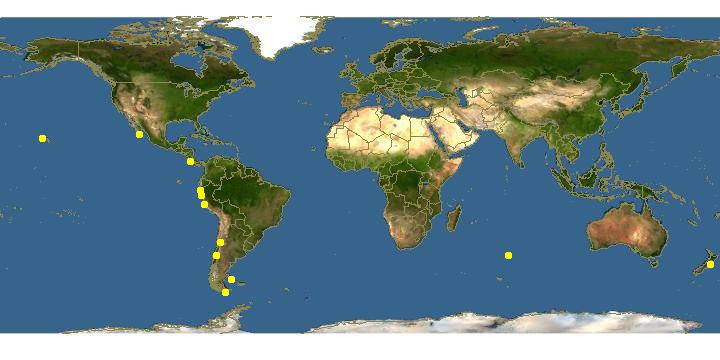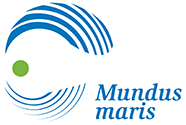
www.fao.org Copyright Michel Lamboeuf · 0
Merluccius gayi peruanus |

Click on map for details about points.
|
| Links |
We parsed the following live from the Web into this page. Such content is managed by its original site and not cached on Discover Life. Please send feedback and corrections directly to the source. See original regarding copyrights and terms of use.
- FishBase
|
|
espa˝ol |
|
|
Overview |
Main identification features
- head 26-32 percentsl
- 2nd dorsal fin 36-42
- gill rakers 18-25
Elongate, compressed, tapering to a narrow tail base; head large (26-32.4% of standard length) and flattened, with a V shape crest on top; large eyes and mouth, lower jaw slightly projecting; jaw teeth long, strong and pointed; 18-25 relatively long rakers on first gill arch; fins without spines; 2 separate dorsal fins, the 1st shorter and higher, the 2nd with a long base (36-42 rays) and partly divided by a notch; well developed, nonfilamentous pelvic fins, situated before the pectorals; pectoral long ľ reaches past anal fin origin; tail fin short, slightly forked; scales small, 106-130 on the lateral line.
Color: Back metallic blue; flanks silvery.
Size: 87cm.
Habitat: pelagic.
Depth: 50-500 m.
Central Peru to Ecuador and the Galapagos.
M gayi includes two subspecies; M. g. peruanus, and M. g. gayi, from Chile.
Attributes
Cites: Not listed.
Climate Zone: Equatorial (Costa Rica to Ecuador + Galapagos, Clipperton, Cocos, Malpelo); South Temperate (Peruvian Province ).
Depth Range Max: 500 m.
Depth Range Min: 50 m.
Diet: octopus/squid/cuttlefish; bony fishes; Pelagic crustacea.
Eastern Pacific Range: Northern limit=2; Southern limit=-14; Western limit=-93; Eastern limit=-76; Latitudinal range=16; Longitudinal range=17.
Egg Type: Pelagic; Pelagic larva.
Feeding Group: Carnivore.
FishBase Habitat: Bathypelagic.
Global Endemism: East Pacific endemic; TEP non-endemic; All species.
Habitat: Water column.
Inshore Offshore: Inshore; Offshore; In & Offshore.
IUCN Red List: Not evaluated / Listed.
Length Max: 87 cm.
Regional Endemism: Peruvian province, primarily; Tropical Eastern Pacific (TEP) non-endemic; Island (s); Continent; Temperate Eastern Pacific, primarily; Continent + Island (s); All species.
Residency: Resident.
Salinity: Marine; Marine Only.
Water Column Position: Near Surface; Mid Water; Near Bottom; Water column only;
|
|
|
Names | |
|
|
|
Links to other sites | |
|
|
|
References |
- Ginsburg, I., 1954., Whitings on the coasts of the American continent., Fishery Bulletin, 56:187-208.
|
|
|
Acknowledgements | |
I thank Ashley MacDonald and John Pickering, University of Georgia, for technical support in building this page.
|
|
| Supported by | |
|
Following modified from FishBase
|
Top | See original
http://www.fishbase.org/Summary/speciesSummary.php?genusname=Merluccius&speciesname=gayi ---> http://192.134.151.83/Summary/speciesSummary.php?genusname=Merluccius&speciesname=gayi
http://192.134.151.83/Summary/speciesSummary.php?genusname=Merluccius&speciesname=gayi ---> https://fishbase.mnhn.fr/Summary/speciesSummary.php?genusname=Merluccius&speciesname=gayi
https://fishbase.mnhn.fr/Summary/speciesSummary.php?genusname=Merluccius&speciesname=gayi ---> https://fishbase.mnhn.fr/summary/Merluccius-gayi.html
Merluccius gayi, South Pacific hake : fisheries
This page is sponsored by
Mundus Maris

Common name (e.g. trout)
Genus + Species (e.g. Gadus morhua)
-

-
About this page
-
Languages
-
User feedbacks
-
Citation
-
Uploads
-
Related species
-


 South Pacific hake
Upload your
photos
and
videos
South Pacific hake
Upload your
photos
and
videos
Pictures
|
Google image
 Merluccius gayi
Merluccius gayi
Picture by
Busse, K.
Teleostei (teleosts) >
Gadiformes
(Cods) >
Merlucciidae
(Merluccid hakes)
Etymology:
Merluccius:
Latin, mar, maris = the sea + Latin, lucius = pike (Ref.
45335
)
.
More on author:
Guichenot
.
Issue
A different species/subspecies is recognized on the Peruvian coasts
Etropus peruanus
Ginsburg, 1954, that is recognized in FishBase as a provisionally valid species. More studies are needed to clearly differentiate it (March 2021).
Environment: milieu / climate zone / depth range / distribution range
Ecology
Marine; bathydemersal; oceanodromous; depth range 50 - 500 m (Ref.
1371
). Deep-water; 5°S - 46°S, 81°W - 69°E (Ref.
54583
)
Southeast Pacific: off the coast of Chile from Arica to Chilo├ę Island.
Length at first maturity / Size / Weight / Age
Maturity: L
m
?
, range 32 - ? cm
Max length : 87.0 cm TL male/unsexed; (Ref.
1371
); common length : 50.0 cm TL male/unsexed; (Ref.
1371
)
Dorsal
spines
(total): 1;
Dorsal
soft rays
(total): 45-54;
Anal
spines
: 0;
Anal
soft rays
: 36 - 42;
Vertebrae
: 49 - 53. Caudal fin margin usually concave. Color is silvery on back, silvery whitish on belly.
M. gayi gayi
and
M. gayi peruanus
differ by the total number of vertebrae, total number of gill rakers and relative length of head (Ref.
1371
).
Occurs from the shallow continental shelf to the upper continental slope (Ref.
1371
). Sometimes found off the bottom or in midwater (Ref.
1371
). Migrates vertically to midwater at night to feed on fishes, squids and euphausiids (Ref.
27363
). Moves to southern coastal areas in summer and migrates to northern deeper waters (200-500 m depth) in winter and spring (Ref.
27363
). Spawning occurs at the end of the winter and during the southern spring (Ref.
58452
). Marketed fresh and frozen (Ref.
1371
) and eaten steamed, fried, boiled and microwaved (Ref.
9988
). Also utilized as fishmeal (Ref.
1371
).
Life cycle and mating behavior
Maturity
|
Reproduction
|
Spawning
|
Eggs
|
Fecundity
|
Larvae
Cohen, D.M., T. Inada, T. Iwamoto and N. Scialabba
, 1990. FAO species catalogue. Vol. 10. Gadiform fishes of the world (Order Gadiformes). An annotated and illustrated catalogue of cods, hakes, grenadiers and other gadiform fishes known to date. FAO Fish. Synop. 125(10). Rome: FAO. 442 p. (Ref.
1371
)
IUCN Red List Status (Ref.
130435
)
Data deficient (DD)
; Date assessed:
01 May 2008
CITES
Not Evaluated
Not Evaluated
Threat to humans
Harmless
Human uses
Fisheries: highly commercial
FAO - Fisheries:
landings
,
species profile
; Publication:
search
|
FishSource
|
Sea Around Us
More information
Countries
FAO areas
Ecosystems
Occurrences
Introductions
Stocks
Ecology
Diet
Food items
Food consumption
Ration
Common names
Synonyms
Metabolism
Predators
Ecotoxicology
Reproduction
Maturity
Spawning
Spawning aggregation
Fecundity
Eggs
Egg development
Age/Size
Growth
Length-weight
Length-length
Length-frequencies
Morphometrics
Morphology
Larvae
Larval dynamics
Recruitment
Abundance
BRUVS
References
Aquaculture
Aquaculture profile
Strains
Genetics
Electrophoreses
Heritability
Diseases
Processing
Nutrients
Mass conversion
Collaborators
Pictures
Stamps, Coins Misc.
Sounds
Ciguatera
Speed
Swim. type
Gill area
Otoliths
Brains
Vision
Tools
E-book
|
Field guide
|
Identification keys
|
Length-frequency wizard
|
Life-history tool
|
Point map
|
Classification Tree
|
Catch-MSY
|
Special reports
Check for Aquarium maintenance
|
Check for Species Fact Sheets
|
Check for Aquaculture Fact Sheets
Download XML
Summary page
|
Point data
|
Common names
|
Photos
Internet sources
AFORO (otoliths)
|
Aquatic Commons
|
BHL
|
Cloffa
|
BOLDSystems
|
Websites from users
|
Check FishWatcher
|
CISTI
|
Catalog of Fishes
:
genus
,
species
|
DiscoverLife
|
ECOTOX
| FAO - Fisheries:
landings
,
species profile
; Publication:
search
|
Faunafri
| Fishipedia |
Fishtrace
| GenBank:
genome
,
nucleotide
| GloBI |
Google Books
|
Google Scholar
|
Google
| IGFA World Record |
MitoFish
| OsteoBase:
skull
,
spine
|
Otolith Atlas of Taiwan Fishes
|
PubMed
| Reef Life Survey | Socotra Atlas |
Tree of Life
| Wikipedia:
Go
,
Search
| World Records Freshwater Fishing |
Zoological Record
Estimates based on models
Preferred temperature (Ref.
123201
): 9.3 - 14, mean 10.9 °C (based on 38 cells).
Phylogenetic diversity index (Ref.
82804
): PD
50
= 0.5000 [Uniqueness, from 0.5 = low to 2.0 = high].
Bayesian length-weight: a=0.01413 (0.00630 - 0.03168), b=3.05 (2.85 - 3.25), in cm total length, based on LWR estimates for this species & (Sub)family-body (Ref.
93245
).
Trophic level (Ref.
69278
): 4.3 ±0.6 se; based on diet studies.
Resilience (Ref.
120179
): Medium, minimum population doubling time 1.4 - 4.4 years (K=0.1-0.2; tm=2).
Fishing Vulnerability (Ref.
59153
): High vulnerability (61 of 100).
Climate Vulnerability (Ref.
125649
): High vulnerability (62 of 100).
Price category (Ref.
80766
):
Low
.
Nutrients (Ref.
124155
): Calcium = 8.76 [3.94, 31.98] mg/100g; Iron = 0.342 [0.068, 0.925] mg/100g; Protein = 17.6 [16.3, 18.9] %; Omega3 = 0.216 [0.103, 0.404] g/100g; Selenium = 22 [10, 49] ╬╝g/100g; VitaminA = 11.9 [2.5, 54.2] ╬╝g/100g; Zinc = 0.223 [0.154, 0.356] mg/100g (wet weight); based on
nutrient studies.
Back to Search
Random Species
Back to Top
Accessed through:
Not available
FishBase mirror site :
localhost
Page last modified by :
mrius-barile
- 20 July 2016
Fatal error
: Uncaught ArgumentCountError: Too few arguments to function checkEcotox(), 1 passed in /var/www/html/summary/speciessummary.php on line 2304 and exactly 3 expected in /var/www/html/includes/speciessummary.lib.php:2579 Stack trace: #0 /var/www/html/summary/speciessummary.php(2304): checkEcotox() #1 {main} thrown in
/var/www/html/includes/speciessummary.lib.php
on line
2579
|
Updated: 2024-06-19 22:25:31 gmt
|